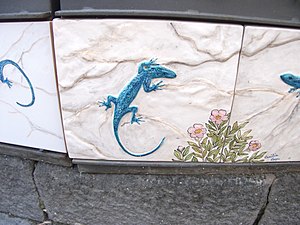Podarcis siculus coeruleus
| Podarcis siculus coeruleus | ||||||||||||
|---|---|---|---|---|---|---|---|---|---|---|---|---|

Podarcis siculus coeruleus as a wall tile relief on Capri |
||||||||||||
| Systematics | ||||||||||||
|
||||||||||||
| Scientific name | ||||||||||||
| Podarcis siculus coeruleus | ||||||||||||
| Bucket , 1872 |
Podarcis siculus coeruleus is one of more than 60 described subspecies of the ruin lizard . As both the Latin suffix “coeruleus” (German blue) and the Italian name “Lucertola Azzurra” (German blue lizard) make clear, their skin has a blue pigmentation . The translation of the Italian name is not common in German-speaking countries, but Blue Lizard is commonin English , especially in English-language academic papers.
features
Like all ruin lizards, the Lucertola Azzurra reaches a total length of up to 25 cm and agrees with them in most of the other body characteristics. However, it differs from all other subspecies, which have a green to brownish color, in its intense blue color and the number of scales in different parts of the body.
distribution
The Lucertola Azzurra used to be considered endemic to the four Faraglioni rocks off the Italian Mediterranean island of Capri , but are now also known to be found on the Faraglioni off the coast of Sicily . The subspecies was described as occurring on the middle and outer Capri-Faraglione in 1872 by the German zoologist Theodor Eimer .
Since the two occurrences are separated by more than 200 km of waterway, science considers the spread from one rock group to the other to be unlikely and assumes two parallel developments.
habitat
The blue body surface is seen as an adaptation to the rocky subsoil, on which there is hardly any green vegetation . The blue color is used to camouflage against animal predators , which are primarily birds of prey given the rocks surrounded by water .
literature
- Silvia Bruschi, Riccardo Maria Cipolla, Claudia Corti, Armando Nappi: Notes on the morphology of Podarcis sicula coerulea compared to other nearby islands and mainland populations of P. sicula. Atti del 6 th Congresso Nazionale della Societas Herpetologica Italica (Roma, 27.IX. – 1.X.2006) . University of Florence 2006 (English, abstract [PDF]).
Web links
- Podarcis sicula ssp. coerulea ( memorial from September 17th, 2013 in the web archive archive.today ), on www.meditflora.com, with three photos
- Photos of the ruin lizard , on www.herp.it, including two pictures of the blue subspecies
Individual evidence
- ↑ Podarcis sicula ssp. coerulea ( memento from September 17, 2013 in the web archive archive.today ).
- ↑ a b c S. Bruschi, RM Cipolla, C. Corti, A. Nappi: Notes on the morphology of Podarcis sicula coerulea compared to other nearby islands and mainland populations of P. sicula . 2006.
- ^ Willi Schmitz: The Faraglione Lizard . In: Sheets for aquarium and terrarium customers . Stuttgart 1890, p. 171 .
- ↑ a b c The flora and fauna of Capri Italy. The Blue Lizard (Podarcis sicula coerulea). capri.com, accessed February 6, 2014 .
- ↑ Podarcis sicula ssp. coerulea ( Memento from September 17, 2013 in the web archive archive.today ), 1st line marked in yellow.


